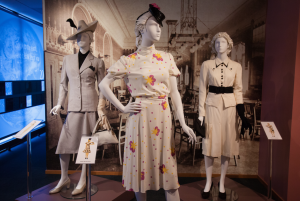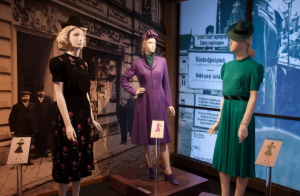
Posed on display at the Jewish Museum Milwaukee are eight mannequins dressed eloquently in 1930s fashion. However, they are more than just well crafted clothes, their get-ups tell a story of a woman named Hedvika Strnad.
The exhibit “Stitching History from the Holocaust” debuted in September and will run until Feb. 28, 2015. However, the process of compiling the designs and the letter began 15 years ago when relative Burton Strnad found a letter in his basement dating back to Dec. 11, 1939.
Written in cryptic text to avoid censorship from the Nazis, Paul Strnad wrote a letter to his cousin in Milwaukee asking for help in escaping from Czechoslovakia. Included in the letter were designs of eight colored drawings — an evening gown, two coats, two suits and various daytime dresses — hoping it would help Hedvika, also known as Hedy, land a job as a dressmaker and demonstrate how useful they would be in America.
Apart from the letter secretly expressing refuge, the designs and a photograph of the two, not much was known about the Strnad’s until more research was conducted. The efforts to bring Paul and Hedy to America failed, and they unfortunately perished in the Holocaust.
Burton Strnad gave the artifacts to the Jewish Museum Milwaukee in 1997, then known as an archive and historical society before it was converted into a museum in 2008, and the designs and letter were put on display for all to gaze upon and learn from. But the museum wanted to do more to honor the Strnad’s memories by bringing Hedy’s dress designs to life.
Back in the fall of 2012, the Milwaukee Repertory Theater performed the production “The Diary of Anne Frank.” The costumes used in the play reflected the styles of the time. Because of this, the Milwaukee Repertory Theater’s Costume Shop was assigned the task of creating the dresses from Hedy’s work and embarked on the journey in 2013.

To do Hedy’s designs justice, the team of 10 people researched pieces from the era and began to carefully construct the dresses. Each article of clothing was meticulously created with Hedy’s vision in mind. The buttons were hand covered, the zippers were vintage and the patterns were hand painted. Even the tags inside the clothing have her name written on them in a way that reflects her actual signature. In all, the project took about 3,000 hours of work to complete.
Had Hedy and her husband successfully escaped Czechoslovakia, perhaps the women in Milwaukee would have been wearing her dresses—admiring their reflections in the mirror—instead of marveling at them on the mannequins in a museum. Ellie Gettinger, the educational director at the Jewish Museum Milwaukee, hopes that if Hedy could see her dresses, she would approve of their adaptation of her designs.
“I think she would be proud of this achievement,” Gettinger said. “This is like a message in a bottle in some ways. This was a plea for help during a time in which they’re demonstrating their usefulness in order to be able to come to this country. And I think we have shown by the recreation how talented this woman was.”
“These are really fine beautiful sketches that are wearable, and would really sit with this time period,” she continued. “I think she would have loved the work the Milwaukee Rep team put into her work.”
Tickets for “Stitching History from the Holocaust” can be purchased at the Jewish Museum Milwaukee. The museum is open on Monday through Thursday from 10 a.m. to 4 p.m., on Friday from 10 a.m. to 2 p.m., and on Sunday from noon to 4 p.m. The museum is closed on Saturdays.

